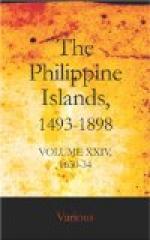[22] Fray Francisco de Bonifacio, a native of Sevilla, took his vows in the Salamanca convent in 1586. He was fluent in the language of Cebu, and labored in various missions among the Bisayas (1596-1611). The latter year he was chosen definitor, and in 1614 presided over the chapter. He was minister at Pasig in 1617, at Tondo in 1618, and at Bulacan in 1620. In 1621 he went to Oton, as his presence there was necessary. In 1626, while definitor, he acted as provincial because of the death of Father Becerra, after which period he had care of missions in Luzon, until his death in Manila in 1645. Two manuscripts written by him were conserved in the convent at Cebu.
Fray Vicente Sepulveda was a native of Castilla, and professed in that province. In the Philippines he became chief sacristan of the Manila convent, and learned thoroughly the Pampanga dialect, ministering in that province for five years. He was definitor in 1611, and provincial in 1614. His term was one of discord because of his rigorous enforcement of the laws passed by the father visitor. In 1617, he was chosen to fill out the term of provincial, that office becoming vacant by the death of Jeronimo de Salas. He was killed August 21, 1617, as the result of a conspiracy of brother Augustinians who were opposed to him.
Fray Diego Gutierrez was a native of Sigueenza in the province of Guadalajara, and professed in the convent of Agreda in 1574. He went to the Philippines in 1578, where he had charge of various missions in Luzon. He served as definitor during the chapters of 1578 and 1590. His death occurred at Lubao in 1613.
Fray Antonio de Porras was born in Sevilla and professed in the convent of that city. He arrived at Manila in 1598, where he exercised the duty of master of novitiates in the convent. He went to Bisayas instead of Japan which was his chosen field, working there from 1600 to 1639 (the year of his death). He held several important ecclesiastical offices in the Bisayas.
See Perez’s Catalogo.
[23] Definitors are the fathers who compose the council of the provincial. Aditos are those who are to be substituted for any definitor because of his death.—Coco.
[24] Fray Fernando Becerra was born in Valladolid and took his vows in the convent of Salamanca, where he read sacred theology. On going to the Philippines he was missionary in Bantay in 1611, preacher and reader in 1613, provincial secretary in 1614, missionary at Hagonoy in 1615, at Pasig, 1617, 1620, and 1623, after having served as visitor and definitor. He was elected provincial by acclamation in 1626, but died July 31 of the same year. He left several writings. See Perez’s Catalogo, pp. 81, 82.
[25] Fray Alonso Mentrida, an illustrious Bisayan missionary and a noted writer, was born in the city of Mentrida, and took his vows in the convent of Casarrubios in 1590, where he became reader for some time, later exercising the same duty at Manila and Lubao until he went to the Bisayas, where most of his work thereafter lay, although he ministered in some of the Luzon missions. He served as definitor in 1614, as prior of Manila in 1618, and as provincial in 1623. He died at the age of seventy-eight, on March 22, 1637. He compiled a grammar and dictionary in Bisayan dialects. See Perez’s Catalogo, pp. 53-55.




